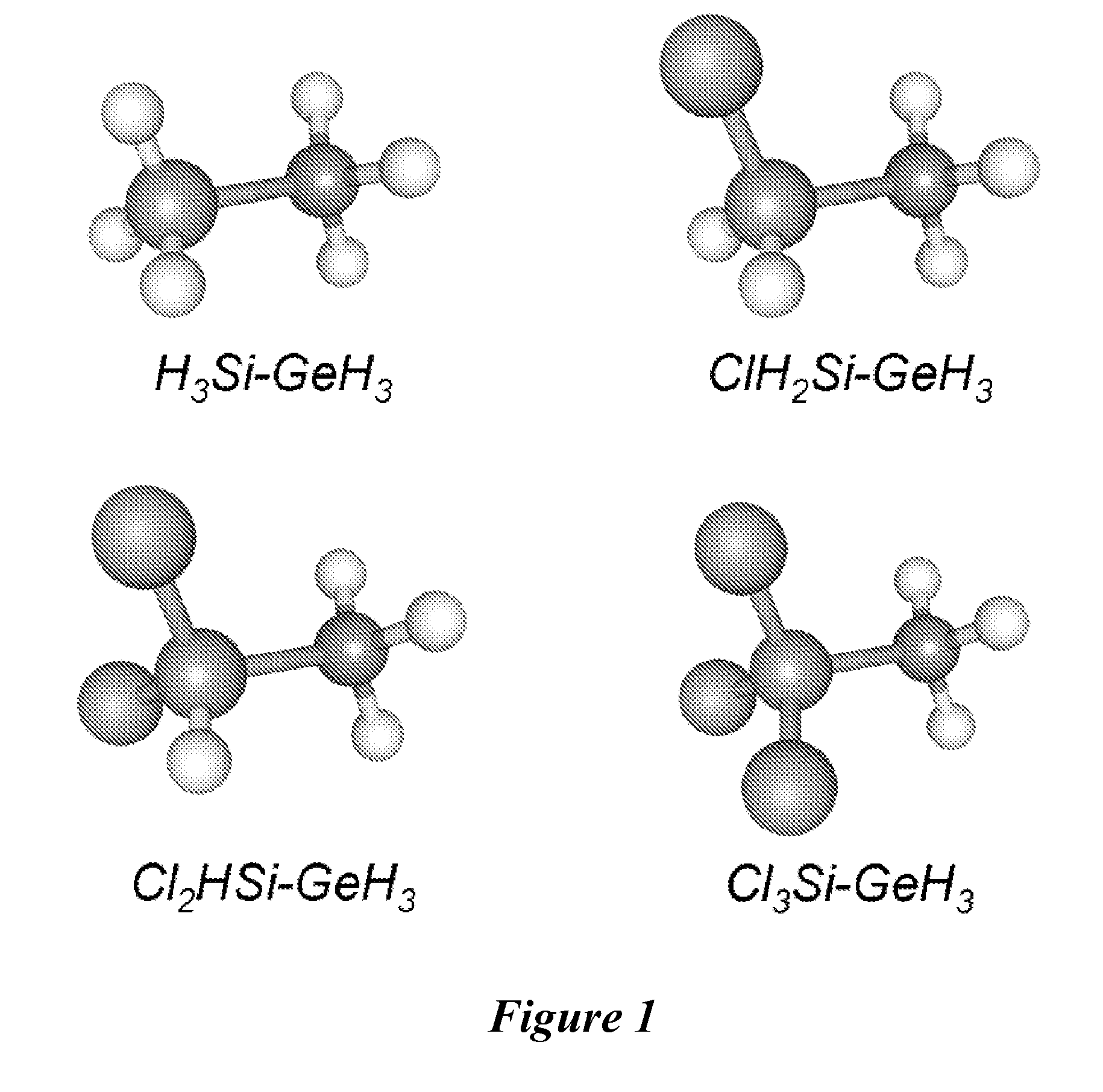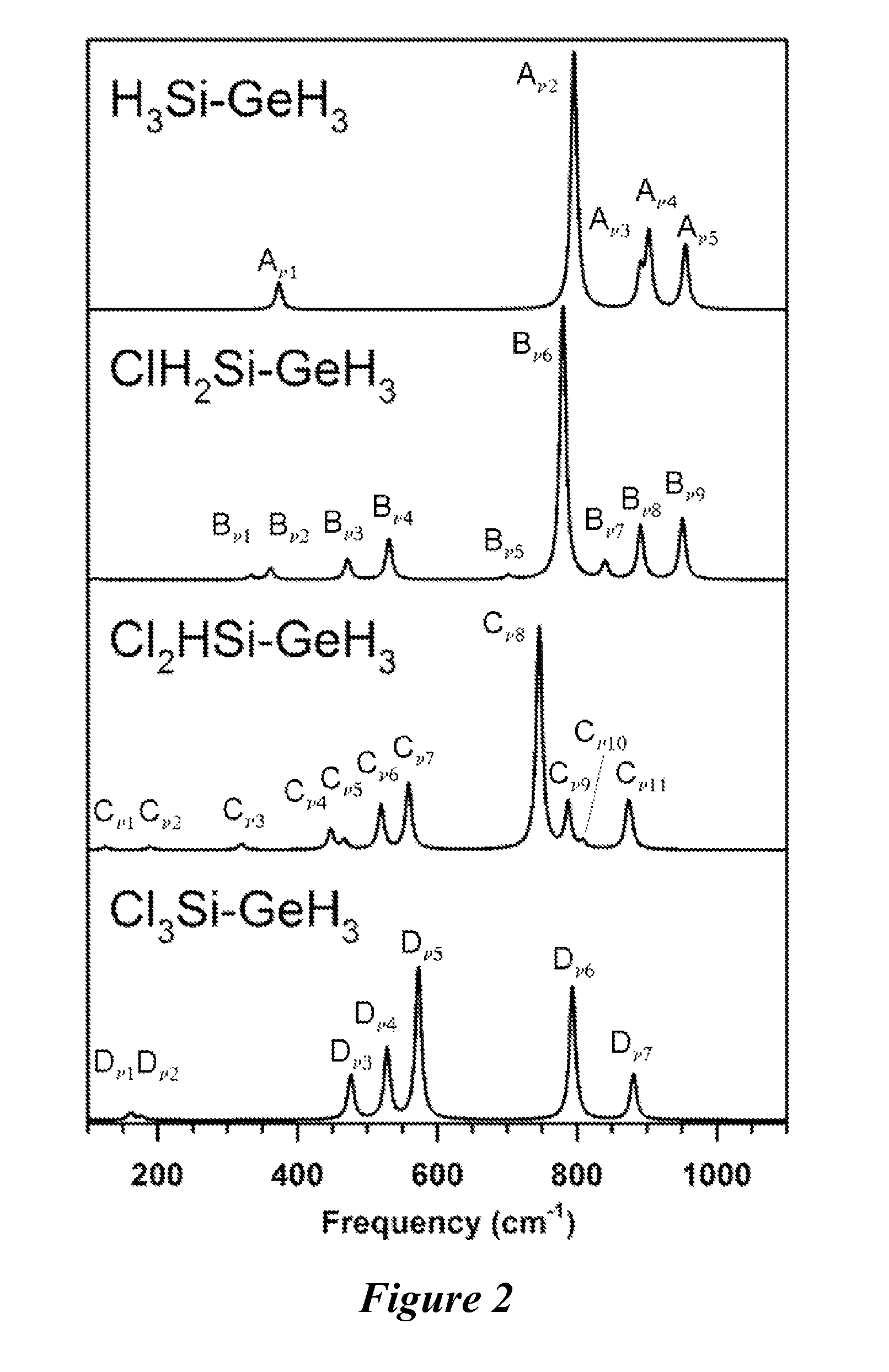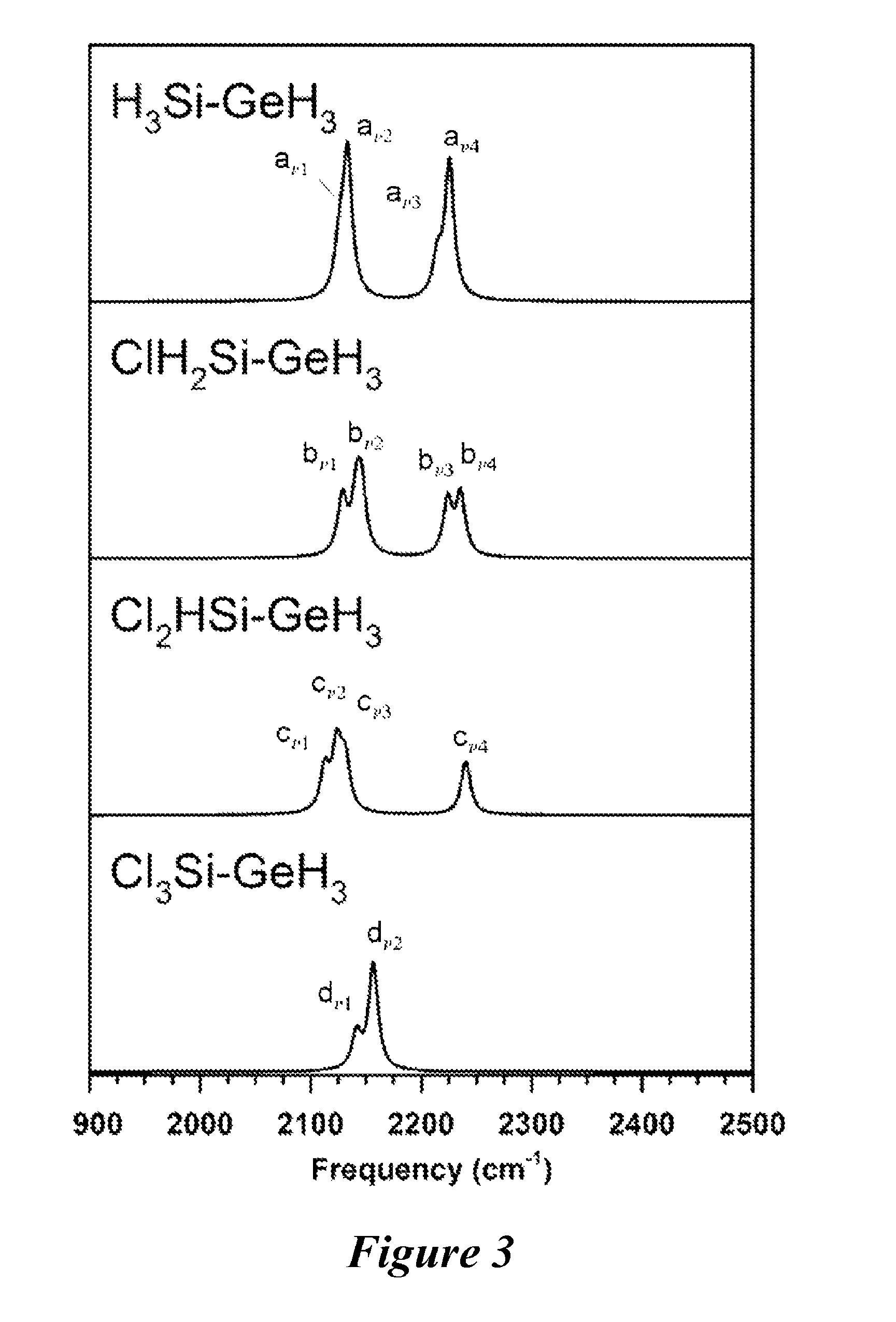Methods for making and using halosilylgermanes
a technology of halolylgermane and germane, which is applied in the field of chemistry, optoelectronics, silicongermanium alloys, semiconductor structures, can solve the problems of lack of compositional control, complicated and difficult best current route to these materials, and material development is much less developed, so as to promote selective growth and increase kinetic stability , the effect of promoting selective growth
- Summary
- Abstract
- Description
- Claims
- Application Information
AI Technical Summary
Benefits of technology
Problems solved by technology
Method used
Image
Examples
example 1
Synthesis of ClSiH2GeH3 and Cl2SiHGeH3
Method A (Reaction of CsCl with (CF3SO3)SiH2GeH3)
[0501]A 50 mL Schlenk flask was charged with n-decane (15 mL) and (CF3SO3)SiH2GeH3 (0.60 g, 2.35 mmol). Cesium chloride (0.42 g, 2.49 mmol) was added slowly via a powder addition funnel at −25° C. to the flask and was allowed to stir under nitrogen for 12 hours at 22° C. The volatiles were fractionally distilled through U-traps held at −50, −110, and −196° C. under dynamic vacuum. The −50° C. trap contained solvent, and the −196° C. trap contained traces of GeH4. The −110° C. trap retained pure, colorless ClSiH2GeH3 (0.186 g, 56% yield). Vapor pressure: ˜147 Torr (23° C.). IR (gas, cm−1): IR (gas, cm−1) 2183 (vs), 2171 (s), 2156 (vw), 2092 (vw), 2082 (vs), 2070 (s), 1076 (vw), 948 (m), 936 (m), 896 (m), 839 (vw), 830 (vw), 790 (s), 774 (vs), 764 (vs), 549 (m), 540 (m), 470 (w), 360 (vw). 1H NMR (300 MHz, toluene-d8): 4.63 (q, 2H, Si—H2), 3.07 (t, 3H, Ge—H3). Mass Spectrum: m / q isotopic envelopes ...
example 2
Synthesis of ClSiH2GeH3 and Cl2SiHGeH3
Method B (reaction of H3SiGeH3 with BCl3)
[0502]Gaseous BCl3 (0.35 g, 3 mmol), and H3SiGeH3 (0.96 g, 9 mmol) were condensed into 150 mL stainless steel cylinder at −196° C. equipped with a high vacuum valve. The cylinder and its contents were held at 0° C. for eight hours after which time the contents were distilled through U-traps held at −78 and −196° C. The latter contained predominately B2H6 and a small amount of H3SiGeH3 as evidenced by IR spectroscopy. A liquid was condensed in the −78° C. and was analyzed by 1H NMR (300 MHz, toluene-d8). The spectra showed a mixture of ClSiH2GeH3 [δ4.63 (q, 2H, S1—H2), δ 3.07 (t, 3H, Ge—H3)], and Cl2SiHGeH3 [δ5.51 (q, H, Si—H), δ 3.20 (d, 3H, Ge—H3)]. The integrated 1H NMR peak intensities of the Ge—H3 resonances indicated a ˜4:1 ratio of ClSiH2GeH3 to Cl2SiHGeH3. This reaction yielded 5.70 mmol of ClH2SiGeH3 and 1.48 mmol of HCl2SiGeH3 indicating a ˜80% molar conversion with respect to the starting H3SiG...
example 3
Reaction of 1:3 BCl3 / SiH2(GeH3)2
[0503]Gaseous BCl3 (0.12 g, 1.05 mmol), and SiH2(GeH3)2 (0.57 g, 3.14 mmol) were condensed into a 50 mL round bottom flask. The flask and its contents were held at 0° C. for 2 h after which time, the volatiles were passed through U-traps held at −40, −60, and −196° C. The latter contained B2H6 (0.5 mmol, 100% yield) and a minor amount of starting material as evidenced by gas IR spectroscopy. The −60° C. trap contained pure 1 as a clear, colorless liquid. The −40° C. trap contained a mixture of 1 and 2 as evidenced by 1H NMR. The yields for 1 and 2 were found to be 0.38 mmol (36%) and 0.03 mmol (3%), respectively. ClHSi(GeH3)2: IR (gas, cm−1): 2153 (m), 2088 (s), 2075 (s), 880 (s), 793 (s), 767 (vs), 697 (vs), 573 (w), 549 (w), 469 (w), 411 (vw). 1H NMR (500 MHz, C6D6): δ 5.07 (septet, H, J=3.5 Hz, SiH), 3.28 (d, 6H, J=3.5 Hz, Ge—H3). 29Si (500 MHz, C6D6): δ−14.71. Mass Spectrum: m / z isotopic envelopes centered at 207 (M+), 172 (SiGe2Hx+), 144 (Ge2Hx+...
PUM
| Property | Measurement | Unit |
|---|---|---|
| reaction temperature | aaaaa | aaaaa |
| temperature | aaaaa | aaaaa |
| reaction temperature | aaaaa | aaaaa |
Abstract
Description
Claims
Application Information
 Login to View More
Login to View More - R&D
- Intellectual Property
- Life Sciences
- Materials
- Tech Scout
- Unparalleled Data Quality
- Higher Quality Content
- 60% Fewer Hallucinations
Browse by: Latest US Patents, China's latest patents, Technical Efficacy Thesaurus, Application Domain, Technology Topic, Popular Technical Reports.
© 2025 PatSnap. All rights reserved.Legal|Privacy policy|Modern Slavery Act Transparency Statement|Sitemap|About US| Contact US: help@patsnap.com



